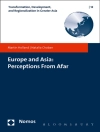Strategic Adjustment and the Rise of China demonstrates how structural and domestic variables influence how East Asian states adjust their strategy in light of the rise of China, including how China manages its own emerging role as a regional great power. The contributors note that the shifting regional balance of power has fueled escalating tensions in East Asia and suggest that adjustment challenges are exacerbated by the politics of policymaking. International and domestic pressures on policymaking are reflected in maritime territorial disputes and in the broader range of regional security issues created by the rise of China.Adjusting to power shifts and managing a new regional order in the face of inevitable domestic pressure, including nationalism, is a challenging process. Both the United States and China have had to adjust to China’s expanded capabilities. China has sought an expanded influence in maritime East Asia; the United States has responded by consolidating its alliances and expanding its naval presence in East Asia. The region’s smaller countries have also adjusted to the rise of China. They have sought greater cooperation with China, even as they try to sustain cooperation with the United States. As China continues to rise and challenge the regional security order, the contributors consider whether the region is destined to experience increased conflict and confrontation.Contributors Ian Bowers, Norwegian Defence University College and Norwegian Institute for Defence Studies
Daniel W. Drezner, Tufts University, Brookings Institution, and Washington Post
Taylor M. Fravel, Massachusetts Institute of Technology
Bjørn Elias Mikalsen Grønning, Norwegian Defence University College and Norwegian Institute for Defence Studies
Chung-in Moon, Yonsei University and Chairman, Presidential Committee on Northeast Asia Cooperation Initiative, Republic of Korea
James Reilly, University of Sydney
Robert S. Ross, Boston College and Harvard University
Randall L. Schweller, The Ohio State University
ystein Tunsjø, Norwegian Defence University College and the Norwegian Institute for Defence Studies
Wang Dong, Peking University
Daftar Isi
Introduction1. Domestic Politics and Nationalism in East Asian Security, Randall L. Schweller2. U.S.–China Relations From Unipolar Hedging toward Bipolar Balancing, Oystein Tunsjo3. Perception, Misperception, and Sensitivity: Chinese Economic Power and Preferences afte rhte 2008 Financial Crisis, Daniel W. Drezner4. Two Asias? China’s Rise, Dual Structure, and the Alliance System in East Asia, Wang Dong Part II Japan, South Korea, and the Rise of China: National Security and Nationalism5. Protecting the Status Quo: Japan’s Response to the Rise of China, Ian bowers and Bjorn Elias Mikasen Gronning6. Popular Nationalism and Economic Interests in China’s Japan Policy, James Reilly7. China’s Rise and Security Dynamics on the Korean Peninsula, Chung-in Moon Part III Great Power Relations and Regional Conflict8. Threading the Needle: The South China Sea Disputes and U.S. China Relations9. The United States and China in Northeast Asia: Third-Party Coercion and Alliance Relations, Robert S. Ross Conclusion: East Asia at the Center: Power Shifts and Theory, Oystein Tunsjo
Tentang Penulis
Robert S. Ross is Professor of Political Science at Boston College and Associate at the John King Fairbank Center for Chinese Studies, Harvard University. He is the author of Chinese Security Policy: Structure, Power, and Politics, coauthor of The Great Wall and the Empty Fortress: China’s Search for Security, and coeditor of China’s Ascent: Power, Security, and the Future of International Politics (also from Cornell), among many other books. Oystein Tunsjo is Professor of International Politics at the Norwegian Defence University College and the Norwegian Institute for Defence Studies. He is the author of Security and Profit in China’s Energy Security Policy: Hedging against Risk and US Taiwan Policy: Constructing the Triangle.












